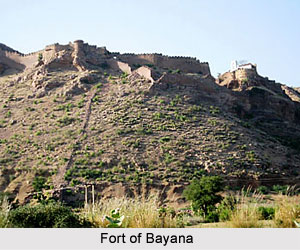 Battle of Khanua was fought between Babur and the Rajput ruler Rana Sanga. The battle took place on 17th march 1527 A.D. The primary cause of the battle of Khanua was the decision of Babur to remain in India as the king of Delhi. Rana Sanga had agreed to support Babur against Ibrahim Lodi. He thought that Babur would leave India after plundering it as was done by his son and the previous invaders. In that case, he could capture Delhi for himself. But the decision of Babur, to remain in India foiled his plans and therefore he preferred to support the Afghans against the Mughal. He gave shelter to fugitive Alam Khan Lodi, accepted Mahmud Lodi as the ruler of Delhi and sought the support of Hasan Khan Mewati and other Afghan nobles against Babur. Therefore, the battle between the Rajputs and the Mughals became inevitable.
Battle of Khanua was fought between Babur and the Rajput ruler Rana Sanga. The battle took place on 17th march 1527 A.D. The primary cause of the battle of Khanua was the decision of Babur to remain in India as the king of Delhi. Rana Sanga had agreed to support Babur against Ibrahim Lodi. He thought that Babur would leave India after plundering it as was done by his son and the previous invaders. In that case, he could capture Delhi for himself. But the decision of Babur, to remain in India foiled his plans and therefore he preferred to support the Afghans against the Mughal. He gave shelter to fugitive Alam Khan Lodi, accepted Mahmud Lodi as the ruler of Delhi and sought the support of Hasan Khan Mewati and other Afghan nobles against Babur. Therefore, the battle between the Rajputs and the Mughals became inevitable.
Babur blamed Rana Sanga for not helping him against Ibrahim Lodi while Rana Sanga challenged the capture of Bayana, Dholpur and Kalpi by Babur. The Rajput army took the offensive and proceeded will a view to capture Bayana and Agra. Mahmud Lodi and Hasar Khan Mewati joined their ranks. The two advanced parties of Babur were defeated by the Rajputs. Babur realised that he had to face a more serious challenge from the Rajputs than what he had faced at Panipat from the Afghans. The Rajput valour was commendable and their leader Rana Sanga was an experienced general who had fought nearly one hundred battles in his life.
The two armies met at Khanua, a place ten miles ahead of Fatehpur Sikri. Babur described the number of the Rajput army as two lakhs. The battle on 17 March 1527 A.D. and continued for ten hours. Rana Sanga was badly wounded and was taken away from the battlefield and the Rajput army was routed. The victory went to the Mughals. Once again, the Mughals succeeded in the battle because of their superior tactics, commandership and artillery. Rana was wounded during the course of the battle and failed to provide leadership to his soldiers at the critical moment. It also demoralised his soldiers.
Battle of Khanua proved to be a more decisive battle as compared to the first battle of Panipat. It proved the superiority of the military tactics of the Mughals against the natives. It weakened the Rajput power. Rana Sanga died in 1528 A.D. and that finished the dream of the Rajputs to conquer Delhi forever. It also reduced the power of resistance of the Afghans against the Mughals. The position of Babur was secure in India. Of course, he had to fight more battles in India but all of them were for the consolidation of their power. Babur was firmly established in India and his centre of power shifted from Kabul to Delhi.



















